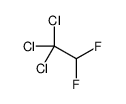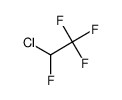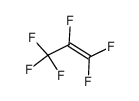| Product name | 1-CHLORO-1,1,2,2-TETRAFLUOROETHANE |
|---|
| Product number | - |
|---|---|
| Other names | Ethane, 1-chloro-1,1,2,2-tetrafluoro- |
| Identified uses | For industry use only. |
|---|---|
| Uses advised against | no data available |
| Company | MOLBASE (Shanghai) Biotechnology Co., Ltd. |
|---|---|
| Address | Floor 4 & 5, Building 12, No. 1001 North Qinzhou Road, Xuhui District, Shanghai, China |
| Telephone | +86(21)64956998 |
| Fax | +86(21)54365166 |
| Emergency phone number | +86-400-6021-666 |
|---|---|
| Service hours | Monday to Friday, 9am-5pm (Standard time zone: UTC/GMT +8 hours). |
no data available
2.2 GHS label elements, including precautionary statements| Pictogram(s) | no data available |
|---|---|
| Signal word | no data available |
| Hazard statement(s) | no data available |
| Precautionary statement(s) | |
| Prevention | no data available |
| Response | no data available |
| Storage | no data available |
| Disposal | no data available |
no data available
3.Composition/information on ingredients 3.1 Substances| Chemical name | Common names and synonyms | CAS number | EC number | Concentration |
|---|---|---|---|---|
| 1-CHLORO-1,1,2,2-TETRAFLUOROETHANE | 1-CHLORO-1,1,2,2-TETRAFLUOROETHANE | 354-25-6 | none | 100% |
Consult a physician. Show this safety data sheet to the doctor in attendance.
If inhaledIf breathed in, move person into fresh air. If not breathing, give artificial respiration. Consult a physician.
In case of skin contactWash off with soap and plenty of water. Consult a physician.
In case of eye contactRinse thoroughly with plenty of water for at least 15 minutes and consult a physician.
If swallowedNever give anything by mouth to an unconscious person. Rinse mouth with water. Consult a physician.
4.2 Most important symptoms/effects, acute and delayedExcerpt from ERG Guide 126 [Gases - Compressed or Liquefied (Including Refrigerant Gases)]: Vapors may cause dizziness or asphyxiation without warning. Vapors from liquefied gas are initially heavier than air and spread along ground. Contact with gas or liquefied gas may cause burns, severe injury and/or frostbite. Fire may produce irritating, corrosive and/or toxic gases. (ERG, 2016)
4.3 Indication of immediate medical attention and special treatment needed, if necessaryVictims of freon inhalation require management for hypoxic, CNS anesthetic, & cardiac symptoms. Patients must be removed from the exposure environment, & high flow supplemental oxygen should be utilized. The respiratory system should be evaluated for injury, aspiration, or pulmonary edema & treated appropriately. CNS findings should be treated supportively. A calm environment with no physical exertion is imperative to avoid increasing endogenous adrenegic levels. Exogenous adrenergic drugs must not be used to avoid inducing sensitized myocardial dysrhythmias. Atropine is ineffective in treating bradyarrhythmias. For ventricular dysrhythmias, diphenylhydantoin & countershock may be effective. Cryogenic dermal injuries should be treated by water bath rewarming at 40-42°C until vasodilatory flush has returned. Elevation of the limb & standard frostbite management with late surgical debridement should be utilized. Ocular exposure requires irrigation & slit lamp evaluation for injury. /Freons/
5.Fire-fighting measures 5.1 Extinguishing media Suitable extinguishing mediaExcerpt from ERG Guide 126 [Gases - Compressed or Liquefied (Including Refrigerant Gases)]: Use extinguishing agent suitable for type of surrounding fire. SMALL FIRE: Dry chemical or CO2. LARGE FIRE: Water spray, fog or regular foam. Move containers from fire area if you can do it without risk. Damaged cylinders should be handled only by specialists. FIRE INVOLVING TANKS: Fight fire from maximum distance or use unmanned hose holders or monitor nozzles. Cool containers with flooding quantities of water until well after fire is out. Do not direct water at source of leak or safety devices; icing may occur. Withdraw immediately in case of rising sound from venting safety devices or discoloration of tank. ALWAYS stay away from tanks engulfed in fire. Some of these materials, if spilled, may evaporate leaving a flammable residue. (ERG, 2016)
5.2 Specific hazards arising from the chemicalExcerpt from ERG Guide 126 [Gases - Compressed or Liquefied (Including Refrigerant Gases)]: Some may burn but none ignite readily. Containers may explode when heated. Ruptured cylinders may rocket. (ERG, 2016)
5.3 Special protective actions for fire-fightersWear self-contained breathing apparatus for firefighting if necessary.
6.Accidental release measures 6.1 Personal precautions, protective equipment and emergency proceduresUse personal protective equipment. Avoid dust formation. Avoid breathing vapours, mist or gas. Ensure adequate ventilation. Evacuate personnel to safe areas. Avoid breathing dust. For personal protection see section 8.
6.2 Environmental precautionsPrevent further leakage or spillage if safe to do so. Do not let product enter drains. Discharge into the environment must be avoided.
6.3 Methods and materials for containment and cleaning upPick up and arrange disposal. Sweep up and shovel. Keep in suitable, closed containers for disposal.
7.Handling and storage 7.1 Precautions for safe handlingAvoid contact with skin and eyes. Avoid formation of dust and aerosols. Avoid exposure - obtain special instructions before use.Provide appropriate exhaust ventilation at places where dust is formed. For precautions see section 2.2.
7.2 Conditions for safe storage, including any incompatibilitiesStore in cool place. Keep container tightly closed in a dry and well-ventilated place.
8.Exposure controls/personal protection 8.1 Control parameters Occupational Exposure limit valuesno data available
Biological limit valuesno data available
8.2 Appropriate engineering controlsHandle in accordance with good industrial hygiene and safety practice. Wash hands before breaks and at the end of workday.
8.3 Individual protection measures, such as personal protective equipment (PPE) Eye/face protectionSafety glasses with side-shields conforming to EN166. Use equipment for eye protection tested and approved under appropriate government standards such as NIOSH (US) or EN 166(EU).
Skin protectionWear impervious clothing. The type of protective equipment must be selected according to the concentration and amount of the dangerous substance at the specific workplace. Handle with gloves. Gloves must be inspected prior to use. Use proper glove removal technique(without touching glove's outer surface) to avoid skin contact with this product. Dispose of contaminated gloves after use in accordance with applicable laws and good laboratory practices. Wash and dry hands. The selected protective gloves have to satisfy the specifications of EU Directive 89/686/EEC and the standard EN 374 derived from it.
Respiratory protectionWear dust mask when handling large quantities.
Thermal hazardsno data available
9.Physical and chemical properties| Physical state | 1-chloro-1,1,2,2-tetrafluoroethane is a colorless odorless nonflammable gas. |
|---|---|
| Colour | Colorless gas |
| Odour | Odorless /Chlorotetrafluoroethane/ |
| Melting point/ freezing point | -117ºC |
| Boiling point or initial boiling point and boiling range | 10ºC |
| Flammability | no data available |
| Lower and upper explosion limit / flammability limit | no data available |
| Flash point | no data available |
| Auto-ignition temperature | no data available |
| Decomposition temperature | no data available |
| pH | no data available |
| Kinematic viscosity | no data available |
| Solubility | In water, 466 mg/L at 25°C (est) |
| Partition coefficient n-octanol/water (log value) | log Kow = 1.86 (est) |
| Vapour pressure | 2.6X10+3 mm Hg at 25°C (est) |
| Density and/or relative density | 1.434g/cm3 |
| Relative vapour density | no data available |
| Particle characteristics | no data available |
no data available
10.2 Chemical stabilityStable under recommended storage conditions.
10.3 Possibility of hazardous reactions1-CHLORO-1,1,2,2-TETRAFLUOROETHANE is chemically inert in many situations, but can react violently with strong reducing agents such as the very active metals and the active metals. They suffer oxidation with strong oxidizing agents and under extremes of temperature.
10.4 Conditions to avoidno data available
10.5 Incompatible materialsno data available
10.6 Hazardous decomposition productsWhen heated to decomposition it emits toxic vapors of /hydrogen fluoride and hydrogen chloride/.
11.Toxicological information Acute toxicity- Oral: no data available
- Inhalation: LC50 Mouse inhalation 1400 g/cu m/2hr
- Dermal: no data available
no data available
Serious eye damage/irritationno data available
Respiratory or skin sensitizationno data available
Germ cell mutagenicityno data available
Carcinogenicityno data available
Reproductive toxicityno data available
STOT-single exposureno data available
STOT-repeated exposureno data available
Aspiration hazardno data available
12.Ecological information 12.1 Toxicity- Toxicity to fish: no data available
- Toxicity to daphnia and other aquatic invertebrates: no data available
- Toxicity to algae: no data available
- Toxicity to microorganisms: no data available
no data available
12.3 Bioaccumulative potentialAn estimated BCF of 7.8 was calculated in fish for 1-chloro-1,1,2,2-tetrafluoroethane(SRC), using an estimated log Kow of 1.86(1) and a regression-derived equation(2). According to a classification scheme(3), this BCF suggests the potential for bioconcentration in aquatic organisms is low(SRC).
12.4 Mobility in soilUsing a structure estimation method based on molecular connectivity indices(1), the Koc of 1-chloro-1,1,2,2-tetrafluoroethane can be estimated to be 140(SRC). According to a classification scheme(2), this estimated Koc value suggests that 1-chloro-1,1,2,2-tetrafluoroethane is expected to have high mobility in soil.
12.5 Other adverse effectsno data available
13.Disposal considerations 13.1 Disposal methods ProductThe material can be disposed of by removal to a licensed chemical destruction plant or by controlled incineration with flue gas scrubbing. Do not contaminate water, foodstuffs, feed or seed by storage or disposal. Do not discharge to sewer systems.
Contaminated packagingContainers can be triply rinsed (or equivalent) and offered for recycling or reconditioning. Alternatively, the packaging can be punctured to make it unusable for other purposes and then be disposed of in a sanitary landfill. Controlled incineration with flue gas scrubbing is possible for combustible packaging materials.
14.Transport information 14.1 UN Number| ADR/RID: UN3163 | IMDG: UN3163 | IATA: UN3163 |
| ADR/RID: LIQUEFIED GAS, N.O.S. |
| IMDG: LIQUEFIED GAS, N.O.S. |
| IATA: LIQUEFIED GAS, N.O.S. |
| ADR/RID: unknown | IMDG: unknown | IATA: unknown |
| ADR/RID: unknown | IMDG: unknown | IATA: unknown |
| ADR/RID: no | IMDG: no | IATA: no |
no data available
14.7 Transport in bulk according to Annex II of MARPOL 73/78 and the IBC Codeno data available
15.Regulatory information 15.1 Safety, health and environmental regulations specific for the product in question| Chemical name | Common names and synonyms | CAS number | EC number |
|---|---|---|---|
| 1-CHLORO-1,1,2,2-TETRAFLUOROETHANE | 1-CHLORO-1,1,2,2-TETRAFLUOROETHANE | 354-25-6 | none |
| European Inventory of Existing Commercial Chemical Substances (EINECS) | Listed. | ||
| EC Inventory | Listed. | ||
| United States Toxic Substances Control Act (TSCA) Inventory | Listed. | ||
| China Catalog of Hazardous chemicals 2015 | Not Listed. | ||
| New Zealand Inventory of Chemicals (NZIoC) | Listed. | ||
| Philippines Inventory of Chemicals and Chemical Substances (PICCS) | Not Listed. | ||
| Vietnam National Chemical Inventory | Not Listed. | ||
| Chinese Chemical Inventory of Existing Chemical Substances (China IECSC) | Listed. | ||
| Creation Date | Aug 12, 2017 |
|---|---|
| Revision Date | Aug 12, 2017 |
- CAS: Chemical Abstracts Service
- ADR: European Agreement concerning the International Carriage of Dangerous Goods by Road
- RID: Regulation concerning the International Carriage of Dangerous Goods by Rail
- IMDG: International Maritime Dangerous Goods
- IATA: International Air Transportation Association
- TWA: Time Weighted Average
- STEL: Short term exposure limit
- LC50: Lethal Concentration 50%
- LD50: Lethal Dose 50%
- EC50: Effective Concentration 50%
- IPCS - The International Chemical Safety Cards (ICSC), website: http://www.ilo.org/dyn/icsc/showcard.home
- HSDB - Hazardous Substances Data Bank, website: https://toxnet.nlm.nih.gov/newtoxnet/hsdb.htm
- IARC - International Agency for Research on Cancer, website: http://www.iarc.fr/
- eChemPortal - The Global Portal to Information on Chemical Substances by OECD, website: http://www.echemportal.org/echemportal/index?pageID=0&request_locale=en
- CAMEO Chemicals, website: http://cameochemicals.noaa.gov/search/simple
- ChemIDplus, website: http://chem.sis.nlm.nih.gov/chemidplus/chemidlite.jsp
- ERG - Emergency Response Guidebook by U.S. Department of Transportation, website: http://www.phmsa.dot.gov/hazmat/library/erg
- Germany GESTIS-database on hazard substance, website: http://www.dguv.de/ifa/gestis/gestis-stoffdatenbank/index-2.jsp
- ECHA - European Chemicals Agency, website: https://echa.europa.eu/































